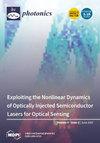利用机器学习方法改进双色温度传感:通过溶液燃烧合成(SCS)制备 GdVO4:Sm3+
IF 2.1
4区 物理与天体物理
Q2 OPTICS
引用次数: 0
摘要
采用溶液燃烧合成(SCS)法制备了掺杂钐的钆钒酸盐(GdVO4:Sm3+)纳米粉体。合成后,为了使材料达到完全结晶,将其在 900 °C 的空气中退火。通过 X 射线衍射对退火后的粉末样品进行了相鉴定,并通过高分辨率扫描电子显微镜(SEM)和透射电子显微镜(TEM)对其形貌进行了研究。利用可调谐激光光参量振荡器激发和条纹照相机对发射光谱和时间分辨分析进行了光致发光表征。除了钐发射带之外,检测系统还观测到了主 VO43- 的微弱宽发光发射带。在早先的工作中,我们分析了利用宿主发光进行双色温度传感的可能性,并通过在线强比测量中引入时间依赖性来改进该方法。在这里,我们证明了使用机器学习方法可以进一步改进。为便于进行初步数据评估,我们对不同温度下的 GdVO4:Sm3+ 光谱进行了主成分分析 (PCA)、t-分布随机邻域嵌入 (t-SNE) 和均匀曲面逼近与投影 (UMAP) 聚类。使用深度神经网络获得了良好的温度预测结果。数据增强技术提高了深度学习网络的性能。本文章由计算机程序翻译,如有差异,请以英文原文为准。
Improving the Two-Color Temperature Sensing Using Machine Learning Approach: GdVO4:Sm3+ Prepared by Solution Combustion Synthesis (SCS)
The gadolinium vanadate doped with samarium (GdVO4:Sm3+) nanopowder was prepared by the solution combustion synthesis (SCS) method. After synthesis, in order to achieve full crystallinity, the material was annealed in air atmosphere at 900 °C. Phase identification in the post-annealed powder samples was performed by X-ray diffraction, and morphology was investigated by high-resolution scanning electron microscope (SEM) and transmission electron microscope (TEM). Photoluminescence characterization of emission spectrum and time resolved analysis was performed using tunable laser optical parametric oscillator excitation and streak camera. In addition to samarium emission bands, a weak broad luminescence emission band of host VO43− was also observed by the detection system. In our earlier work, we analyzed the possibility of using the host luminescence for two-color temperature sensing, improving the method by introducing the temporal dependence in line intensity ratio measurements. Here, we showed that further improvements are possible by using the machine learning approach. To facilitate the initial data assessment, we incorporated Principal Component Analysis (PCA), t-Distributed Stochastic Neighbor Embedding (t-SNE) and Uniform Manifold Approximation and Projection (UMAP) clustering of GdVO4:Sm3+ spectra at various temperatures. Good predictions of temperature were obtained using deep neural networks. Performance of the deep learning network was enhanced by data augmentation technique.
求助全文
通过发布文献求助,成功后即可免费获取论文全文。
去求助
来源期刊

Photonics
Physics and Astronomy-Instrumentation
CiteScore
2.60
自引率
20.80%
发文量
817
审稿时长
8 weeks
期刊介绍:
Photonics (ISSN 2304-6732) aims at a fast turn around time for peer-reviewing manuscripts and producing accepted articles. The online-only and open access nature of the journal will allow for a speedy and wide circulation of your research as well as review articles. We aim at establishing Photonics as a leading venue for publishing high impact fundamental research but also applications of optics and photonics. The journal particularly welcomes both theoretical (simulation) and experimental research. Our aim is to encourage scientists to publish their experimental and theoretical results in as much detail as possible. There is no restriction on the length of the papers. The full experimental details must be provided so that the results can be reproduced. Electronic files and software regarding the full details of the calculation and experimental procedure, if unable to be published in a normal way, can be deposited as supplementary material.
 求助内容:
求助内容: 应助结果提醒方式:
应助结果提醒方式:


